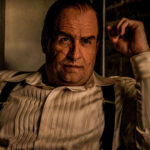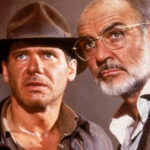

“Rocky”, the iconic film that catapulted Sylvester Stallone to stardom and defined an entire cinematic genre, is not just a boxing story. Behind the fists and the ring, there’s a world of fascinating curiosities that contributed to making this classic unforgettable. From the unlikely inspiration for the plot to behind-the-scenes of filming and the lasting cultural impact, “Rocky” is a treasure trove of surprises and insights that reveal much more than meets the eye. In this text, we’ll explore some of the most intriguing curiosities surrounding this cinema masterpiece. Get ready for a journey behind the scenes of one of the most beloved sagas in cinema history.
1 – INSPIRATION
Stallone’s inspiration to write the screenplay came after witnessing the epic fight between Chuck Wepner and Muhammad Ali on March 24, 1975, at the Richfield Coliseum in Ohio. Wepner, then 36 years old, was considered a mediocre boxer, with little expectation of defeating Ali. Surprisingly, Wepner managed to hold on for over three rounds, leaving everyone in awe as the fight progressed. Although Wepner lost the match, it was only in the fifteenth and final round, with just 19 seconds left until the end.
2 – EXTREME DIFFICULTIES
Turning Rocky into a film was truly a challenging journey. After numerous rejections while pitching the screenplay, Sylvester Stallone finally found interest from producers Irwin Winkler and Robert Chartoff. Despite being offered a substantial sum of $350,000 for the screenplay rights, Stallone refused to sell it unless he was given the lead role, even facing extreme financial difficulties – he had only $106 in the bank, no car, and even contemplated selling his dog due to struggling to feed him.
The producers agreed, but under the condition that Stallone would continue to work as a writer without receiving a commission and that he would accept a minimum salary as an actor. Taking the film to United Artists, they expected a budget of $2 million, counting on an established star like Robert Redford, Ryan O’Neal, Burt Reynolds, or James Caan in the lead role – they did not want Stallone for the part.
However, the producers insisted that they would only negotiate the screenplay if Stallone portrayed Rocky. The studio slashed the budget to $1 million, and Chartoff and Winkler had to agree that they would be personally responsible if the film exceeded this limit. The final cost was $1.1 million, with the last $0.1 million being financed after Chartoff and Winkler mortgaged their homes to complete the project.
3 – THE SKATING SCENE
The scene originally planned for the ice rink involved 300 extras, but the production faced difficulties in gathering that number of people. When Sylvester Stallone arrived to shoot the scene, he was shocked to discover there was only one extra available. Despite this, he quickly adapted the scene and filmed it on the empty rink, resulting in the version we know. Ironically, this scene became one of the most beloved in the entire Rocky saga. Furthermore, it’s interesting to note that Stallone didn’t know how to skate, so he incorporated into the script the idea of his character walking alongside Adrian.
4 – THE ICONIC STAIRWAY SCENE
The iconic scene of Rocky ascending the steps of the Philadelphia Museum of Art had its origins thanks to Garrett Brown, the inventor of the Steadicam. Brown, a Philadelphia native, was about to travel to Los Angeles to try to sell his newly created device. He had already filmed some tests following people through corridors and rooms, but he wanted to capture something that would even leave seasoned filmmakers intrigued about how he had achieved it. That’s when he came up with the idea of filming his girlfriend running up and down the museum steps while he followed her with the Steadicam.
With this footage, Brown managed to sell his camera on the first day in Los Angeles. A few months later, John G. Avildsen, who was directing Rocky at the time, saw the recording and realized it would be perfect for the movie. Avildsen then hired Brown and his Steadicam, and, as Brown recalls, months after filming his girlfriend, he was contributing to one of cinema’s most memorable scenes.
5 – DRUNK TEACHING IN ACTING
According to reports from Burt Young, while filming the scene where Paulie returns home drunk, a real alcoholic passed by the set and told Young that his performance wasn’t convincing. Faced with this, Young asked the man to demonstrate the proper way. He then imitated the man’s movements for the scene.
6 – THE TRAINER MICKEY
Burgess Meredith was chosen for the role of trainer Mickey because other actors felt offended when asked to read the script to Stallone.
7 – SUDDEN CHANGES IN THE SCRIPT
It is widely known that Sylvester Stallone wrote the first draft of the script in just three days. However, the script underwent nine revisions before being acquired by Winkler and Chartoff. Initially, the plot had a much darker tone. Mickey was portrayed as an elderly and bitter man with racist attitudes, and the film would have ended with Rocky quitting the fight as he realized he no longer wanted to be part of the professional boxing world.
8 – COMPLETELY IMPROVISED SCENES
Most of the scenes of Rocky running through the streets of Philadelphia were shot in an improvised manner, without formal permissions, equipment, or extras. For example, the scene where he runs alongside a docked boat was a spontaneous idea. As the crew drove through the docks, director John G. Avildsen spotted the boat and decided it would be an interesting backdrop. So, he asked Stallone to get out of the van and run along the docks while Avildsen himself filmed from the side door.
A similar situation occurred in the famous scene where Rocky runs through the street fair. If you look closely, you can see the vendors at the stalls and the people on the sidewalks looking puzzled at him. Although this added to the film’s atmosphere, they actually had no idea what was happening – a man running down the street being filmed from a van. The part where the stall owner throws an orange to Rocky was completely improvised by the vendor himself, who had no idea he was participating in a production that would become a major cinema success.
9 – REAL FIGHTERS DECLINED TO PARTICIPATE
Initially, the producers planned to feature several former heavyweight champions to make an appearance at the beginning of the fight between Rocky and Apollo. A call was put out for all former champions to attend, but on the day of filming, only Joe Frazier was present. Nevertheless, filmmakers considered this to work out positively, as Frazier is a native of Philadelphia, where the story is set and was filmed.
10 – CARL WEATHERS ACTUALLY HIT SYLVESTER STALLONE
During the audition for the role of Apollo, Carl Weathers got so involved in the sparring scene with Stallone that he ended up hitting him on the chin. Stallone had to remind him that it was just an audition and asked him to calm down. Weathers confidently replied that if he were acting opposite a real actor instead of a stand-in, he would do even better. That’s when John G. Avildsen intervened, informing Weathers that Stallone was indeed the lead actor and the screenwriter. After a moment of reflection, Weathers commented, “Well, he’ll be fine.” Stallone didn’t hesitate to hire him for the role.
11 – ELVIS PRESLEY WATCHED THE MOVIE BEFORE ITS RELEASE
During an interview, Sylvester Stallone was asked if he had ever met Elvis Presley. Stallone shared that in 1976, after the release of “Rocky,” Elvis reached out to him and invited him to visit Graceland and bring a copy of the movie. Stallone admitted to the interviewer that he was extremely nervous about the idea of meeting Elvis, so he ended up not going but sent a copy of the film instead. It later became clear that Elvis did indeed watch the movie in the company of some friends.
12 – 35 HOURS OF REHEARSAL
Before filming the fight between Rocky and Apollo, director John G. Avildsen decided that the scenes needed to have a unique style, aiming to make the boxing more realistic than usual in films of the time. He, along with Carl Weathers and Sylvester Stallone, went to a boxing ring to start rehearsing the movements, but soon realized that something wasn’t working. The fight seemed too rehearsed and lacked energy.
After the fight doubles and choreographers, Paul Stader and George P. Wilbur, left the project due to creative differences, Avildsen suggested to Stallone that he go home and literally write out the sequence of the fight. The next day, Stallone returned with 32 pages containing detailed instructions for the fight, which he and Weathers learned like a dance over several weeks. In total, Stallone and Weathers rehearsed for over 35 hours.
In essence, delving into the curiosities behind the film “Rocky” reveals not only the challenges faced during its production but also the moments of inspiration, improvisation, and dedication that contributed to its transformation into a cinematic classic. From the behind-the-scenes of the iconic fight scenes to unexpected encounters with figures like Elvis Presley, each detail adds layers of depth to the rich tapestry of this cinematic masterpiece. Behind the standout performances and gripping plot lies a story of determination, creativity, and passion that resonates with audiences to this day. “Rocky” is not just a boxing movie; it’s a lasting testament to the power of the human spirit and the relentless pursuit of greatness, both inside and outside the ring.








